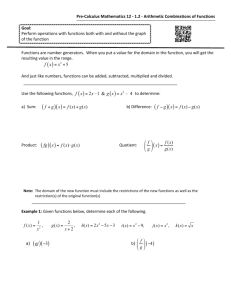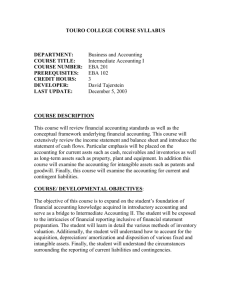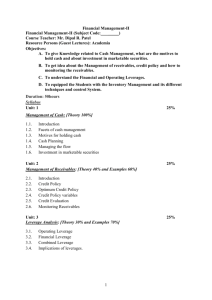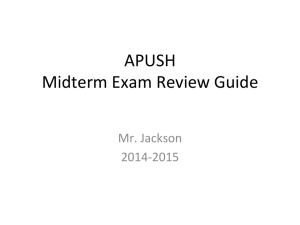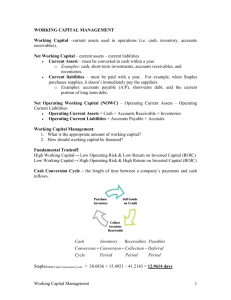AC-320 Intermediate Accounting I
advertisement
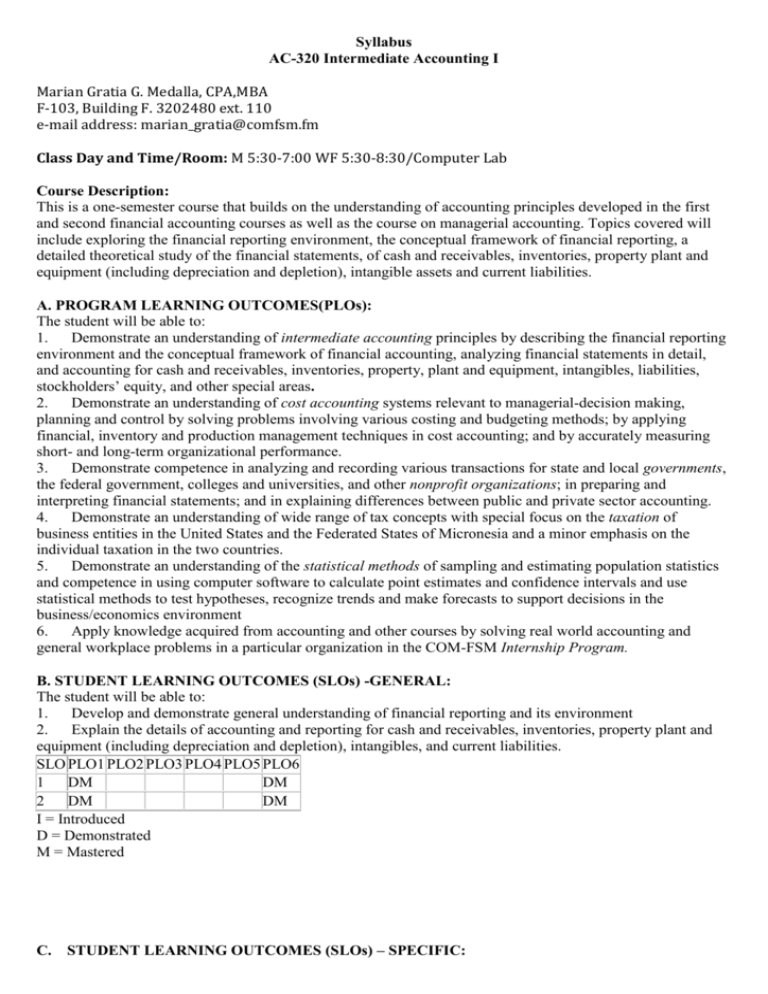
Syllabus AC-320 Intermediate Accounting I Marian Gratia G. Medalla, CPA,MBA F-103, Building F. 3202480 ext. 110 e-mail address: marian_gratia@comfsm.fm Class Day and Time/Room: M 5:30-7:00 WF 5:30-8:30/Computer Lab Course Description: This is a one-semester course that builds on the understanding of accounting principles developed in the first and second financial accounting courses as well as the course on managerial accounting. Topics covered will include exploring the financial reporting environment, the conceptual framework of financial reporting, a detailed theoretical study of the financial statements, of cash and receivables, inventories, property plant and equipment (including depreciation and depletion), intangible assets and current liabilities. A. PROGRAM LEARNING OUTCOMES(PLOs): The student will be able to: 1. Demonstrate an understanding of intermediate accounting principles by describing the financial reporting environment and the conceptual framework of financial accounting, analyzing financial statements in detail, and accounting for cash and receivables, inventories, property, plant and equipment, intangibles, liabilities, stockholders’ equity, and other special areas. 2. Demonstrate an understanding of cost accounting systems relevant to managerial-decision making, planning and control by solving problems involving various costing and budgeting methods; by applying financial, inventory and production management techniques in cost accounting; and by accurately measuring short- and long-term organizational performance. 3. Demonstrate competence in analyzing and recording various transactions for state and local governments, the federal government, colleges and universities, and other nonprofit organizations; in preparing and interpreting financial statements; and in explaining differences between public and private sector accounting. 4. Demonstrate an understanding of wide range of tax concepts with special focus on the taxation of business entities in the United States and the Federated States of Micronesia and a minor emphasis on the individual taxation in the two countries. 5. Demonstrate an understanding of the statistical methods of sampling and estimating population statistics and competence in using computer software to calculate point estimates and confidence intervals and use statistical methods to test hypotheses, recognize trends and make forecasts to support decisions in the business/economics environment 6. Apply knowledge acquired from accounting and other courses by solving real world accounting and general workplace problems in a particular organization in the COM-FSM Internship Program. B. STUDENT LEARNING OUTCOMES (SLOs) -GENERAL: The student will be able to: 1. Develop and demonstrate general understanding of financial reporting and its environment 2. Explain the details of accounting and reporting for cash and receivables, inventories, property plant and equipment (including depreciation and depletion), intangibles, and current liabilities. SLO PLO1 PLO2 PLO3 PLO4 PLO5 PLO6 1 DM DM 2 DM DM I = Introduced D = Demonstrated M = Mastered C. STUDENT LEARNING OUTCOMES (SLOs) – SPECIFIC: The student will be able to: General SLO 1. Develop and demonstrate general understanding of financial reporting and its environment. Student Learning Outcomes Assessment Strategies 1.1 Explain the purpose of financial accounting and the ethical issues facing financial Pre-/Postaccountants. Testing 1.2 Explain the sources of Generally Accepted Accounting Principles (GAAP) and the Pre-/Postindividual components of conceptual framework of financial reporting. Testing 1.3 Explain the entire accounting cycle and how the effectiveness of the accounting Pre-/Postinformation system can affect the quality and accuracy of accounting information. Testing 1.4 Explain the uses and limitations of, and prepare income statement and statement of other Pre-/Postaccumulated comprehensive income in accordance with GAAP. Testing 1.5 Explain the uses and limitations of, and prepare cash flow statement and balance sheet in Pre-/Postaccordance with GAAP. Testing 1.6 Explain the need for, and prepare notes to financial statements. Pre-/PostTesting General SLO 2. Explain the details of accounting and reporting for transactions involving cash and receivables, inventories, property plant and equipment (including depreciation and depletion), intangibles, and current liabilities. Student Learning Outcomes Assessment Strategies 2.1 Identify cash and cash equivalents, prepare entries arising from petty cash transactions, Pre-/Postcorrectly prepare a bank reconciliation statement and bring the cashbook balance to its adjusted Testing amount, and explain how cash is presented in the balance sheet. 2.2 Correctly account for transactions involving accounts receivable, interest bearing and nonPre-/Postinterest bearing notes receivable; and explain how receivables should be presented in financial Testing statements. 2.3 Distinguish inventory from non-inventory items; identify major classifications of inventory; Pre-/Postand account for inventory transactions using perpetual and periodic inventory using FIFO, LIFO, Testing and Average and Specific Identification cost flow assumptions. 2.4 Explain how to report and analyze inventory, using actual inventory balances and if not Pre-/Postavailable, using various methods of inventory estimation, which considers previous purchase Testing commitments made. 2.5 Describe property, plant and equipment, correctly calculate their related acquisition and Pre-/Postafter-acquisition costs to be, and account for all property, plant and equipment transactions. Testing 2.6 Explain the nature of, and issues associated with depreciation, asset impairment, and depletion; compute and compare depreciation using activity, straight-line and decreasing-charge Pre-/Postmethods of depreciation and explain how to report and analyze property, plant and equipment, Testing and asset impairment in financial statements. 2.7 Describe intangible assets and the different types of intangible assets; calculate their costs Pre-/Postand amortization; explain the accounting issues related to intangible asset impairments; and Testing present of intangible assets and related items in financial statements. 2.8 Discuss the nature, type and valuation of current liabilities; and present and analyze Pre-/Postliabilities and contingencies. Testing D. COURSE CONTENT 1. The Financial Accounting and Accounting Standards 2. The Conceptual Framework Underlying Financial Reporting 3. Accounting Information System 4. The Income Statement and Related Information 5. Balance Sheet and Statement of Cash Flows 6. Cash and Receivables 7. Valuation of Inventories: A Cost-Basis Approach 8. Inventories: Additional Valuation Issues 9. Acquisition and Disposition of Property, Plant and Equipment 10. Depreciation, Impairments and Depletion 11. Intangible Assets 12. Current Liabilities and Contingencies E. METHODS OF INSTRUCTION Lectures and electronic presentations Simulation activities (ex. problem solving) Provide student learning resources online. F. REQUIRED TEXT(S) AND COURSE MATERIALS Kieso, Weygant & Warfield: Intermediate Accounting, 14th Edition, Wiley, USA: 2009 (or most recent edition). Calculator, pens, pencil and ruler G. REFERENCE MATERIALS Nikolai, Bazley & Jones: Intermediate Accounting 10th Edition, Thomson South-Western, USA: 2007 (or most recent edition). Stice & Stice: Intermediate Accounting 17th Edition, South-Western College Publishers: 2009 (or most recent edition). H. COMPOSITION OF FINAL GRADES HOMEWORK 10% CLASSWORK 20% QUIZZES 30% EXAMINATION 40% PERIODIC (MIDTERM OR TENTATIVE FINAL) GRADE 100% MIDTERM GRADE TENTATIVE FINAL GRADE TOTAL DIVIDED BY NUMBER OF GRADING PERIODS AVERAGE: FINAL GRADE XX% XX% XX% 2 XX% 90%-100% 80%-89% 70%-70% 60-69% A B C D 59% AND F BELOW I. ACADEMIC HONESTY Any form of cheating is prohibited. Cheaters will get ZERO on that particular evaluation, and possibly be subjected to further disciplinary actions. J. CLASS POLICIES 1. No late assignments/class-works will be accepted. Home-works must be done at home, and not in school. 2. No special quizzes will be given, unless the reason for absence include is either to attend the funeral of a close relative; sickness; to represent the college in an off-campus activity; or if working, if required by the employer, and a valid documentation is presented. 3. Maximum allowable absence is 3. If your absences exceed this number, you will earn F from this class. 4. Cellular phones and other noise making devices must be set on silent mode while inside the class. Taking calls is prohibited inside the class. 5. Tardiness from class is discouraged. 6. Anyone can get an “A”, provided he/she worked hard to deserve it. 6. Changes in the syllabus will be immediately communicated to the class.

